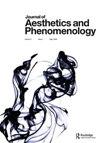Witty Winds: Japanese Contributions to a Phenomenology of Laughter and Irony
IF 0.2
0 PHILOSOPHY
引用次数: 0
Abstract
ABSTRACTThis paper explores philosophically the experiences of laughter and irony, focusing on Japanese sources but with a cross-cultural outlook. I ask whether globally unfavorable attitudes towards the comic in the European canon might have left unexplored or misunderstood several insights offered by the bodily and spiritual dimension revealed by laughter, and examine them through Japanese sources. Following a short but poignant triad of examples in Kuki Shūzō’s work, the paper analyses three instances of Japanese laughter and irony: the orgiastic laughter of the gods luring Amaterasu out of the Heavenly Cave in Kojiki; the anthropomorphic animal scrolls of Chōjūgiga, and the “Tiger Cubs Crossing” stone garden in Ryōanji, Kyoto, concluding how each one of them offers an important insight on the bodily and conceptual phenomenological cluster of laughter and irony. I conclude with a further exploration of laughter in Zen, a religious tradition with a unique stress on the spiritual potential of humor, following Nishitani’s reading of Mumonkan and his connection to the experience of “emptiness”.KEYWORDS: laughterhumorironyfūryūKukiNishitaniZen Disclosure statementNo potential conflict of interest was reported by the author(s).Notes1 For an overview, see Marinucci, “Japanese Atmospheres: Of Sky, Wind and Breathing”.2 Schmitz, Atmosphären, 7–12; for an explicit discussion of the affinity between Schmitz’s phenomenological work and Japanese cultural patters, Ogawa, Philosophy of Wind, 11–28.3 Kuki, “A Reflection on Poetic Spirit”, 96.4 Plessner, Laughing and Crying, 26.5 Ibid., 31–32.6 Ibid., 37.7 Schmitz, Atmosphären, 32–33.8 Kierkegaard, The Concept of Irony, 178.9 Solger, Erwin II, quoted in Garber, Romantic Irony, 71.10 Schlegel, Philosophical Fragments, 24.11 Ibid., 5-6.12 Marinucci “Japanese Atmospheres”.13 Marinucci, “Following the Footsteps of Wind”, 83.14 Kuki, “A Reflection on Poetic Spirit”, 104.15 Heldt, The Kojiki, 24.16 Schmitz, System der Philosophie III-4, 49–50.17 Akutagawa, Akutagawa Zenshū VIII, 195.18 Pinkola Estés, Women who run with the Wolves, 248–9.19 It is worth stressing how often humour and laughter gravitate around holes, either the mouth (laughter, food), or genitals and the anus (sexual humour, scatological humour). Even the word “humour” itself ultimately refers to the bodily fluids (humores) thought to control moods through their attunement to the external world. In order to understand the laughing or comical body, it is essential to include, or even centre our attention on its holes, not simply anatomically, but as the felt-bodily nexuses of our being into the world and with others.20 Plessner, Laughing and Crying, 85.21 Watsuji, Watsuji zenshū VIII, 35.22 Diog. Laer. VI-2 40.23 Sloterdijk, Critique of Cynical Reason, 103.24 Kuki, “A Reflection on Poetic Spirit”, 104.25 Mitate 見立て is a visual pun by which an object is seen or represented as a stand-in for a very different one, creating a comic effect by effectively casting one image as two, often with an interplay between high and low meant to be parodic. It is a staple of Edo visual culture, and often associated with the the comic or erotic sense of fūryū; see Haft, Aesthetic Strategies, 2012.26 Kuki, “A Reflection on Poetic Sprit”, 104.27 Petersen, “Stone Garden”, 111.28 Figal, Aesthetics as Phenomenology, 161.29 Kimura, Karesansuiron no yukue, 64.30 Ōhashi, Kire no kōzō, 79.31 Marinucci, “Sabi and Irony”, 147–9.32 Blyth, Japanese Humour, 89.33 Blyth, Zen and Zen Classics, 76.34 Ibid., 76.35 Cleary, The Blue Cliff Record, 381.36 Ibid., 381.37 Yanagita, Teihon Yanagita Kunio shū IX, 201.38 Hobbes, The Elements of Law, 54.39 Nishitani, “The I-Thou Relation”, 77.40 Ibid., 82.41 Ibid., 87.Additional informationNotes on contributorsLorenzo MarinucciI am currently associate professor of Aesthetics at Tōhoku University, Sendai, Japan. After completing my PhD in University or Rome – Tor Vergata, with a work analysing the role of wind and atmosphere in Japanese aesthetics, I have been Canon Europe Fellow 2020 and Japan Foundation Fellow 2021 at Kyoto University, with a project exploring the relationship of scent and philosophy in Japan (a book project that should be out for Routledge in late 2023). My research topics include phenomenology, new phenomenology, Japanese modern philosophy and aesthetics. I am an active translator from Japanese, English and German, focusing on philosophy, non-fiction and poetry (especially haiku).诙谐之风:日本对笑与反讽现象学的贡献
摘要本文从哲学的角度探讨了笑与反讽的经验,以日本为中心,但又具有跨文化的视角。我的问题是,全球对欧洲经典漫画的负面态度是否可能导致人们对笑所揭示的身体和精神层面所提供的一些见解没有加以探索或误解,并通过日本的资料来研究这些见解。本文分析了菊树Shūzō作品中三个短小但令人心酸的例子,分析了日本人的笑和讽刺的三个例子:《菊树》中众神引诱天照大神走出天洞的狂欢笑声;Chōjūgiga拟人化的动物卷轴,以及京都Ryōanji的“虎崽穿越”石园,总结了它们如何提供了对笑声和讽刺的身体和概念现象学集群的重要见解。最后,我将进一步探讨禅宗中的笑声,禅宗是一种宗教传统,它独特地强调幽默的精神潜力,在西谷读了《舞门馆》和他与“空虚”体验的联系之后。关键词:laughterhumorironyfūryūKukiNishitaniZen披露声明作者未报告潜在的利益冲突。注1概述见Marinucci,“日本大气:天空、风和呼吸”Schmitz, Atmosphären, 7-12;关于施密茨现象学著作与日本文化模式之间的亲缘关系的明确讨论,请见小川,《风的哲学》,11-28.3库基,“对诗性精神的反思”,96.4普勒斯纳,《笑与哭》,26.5同上,31-32.6同上,37.7施密茨,Atmosphären, 32-33.8克尔凯郭尔,《反讽的概念》,178.9索尔格,欧文二世,引自加伯,《浪漫反讽》,71.10施莱格尔,《哲学片段》,24.11同上,5-6.12 Marinucci《日本氛围》Marinucci,“追随风的脚步”,83.14 Kuki,“诗性精神的反思”,104.15 Heldt, the Kojiki, 24.16 Schmitz, System der Philosophie iii - 4,49 - 50.17芥川,芥川真史八,195.18 Pinkola est,与狼一起奔跑的女人,248-9.19值得强调的是,幽默和笑声经常被吸引到孔周围,不是嘴巴(笑声,食物),就是生殖器和肛门(性幽默,粪便幽默)。甚至“幽默”这个词本身最终也指体液(幽默),人们认为体液通过与外部世界的协调来控制情绪。为了理解笑的或滑稽的身体,有必要把我们的注意力集中在身体的孔上,不仅是解剖学上的孔,而且是我们与世界以及与他人联系的感觉-身体的纽带普勒斯纳,笑与哭,85.21 Watsuji, Watsuji zenshya VIII, 35.22 Diog。的激光。VI-2 40.23 Sloterdijk,《愤世嫉俗的理性批判》,103.24 Kuki,《对诗歌精神的反思》,104.25 Mitate是一种视觉上的双关语,通过这种双关语,一个物体被视为或代表一个非常不同的物体,通过有效地将一个形象塑造成两个形象来创造一种喜剧效果,通常带有高与低之间的相互作用,这是为了模仿。它是江户视觉文化的主要内容,经常与fūryū的漫画或情色感联系在一起;参见哈夫特,美学策略,2012.26 Kuki,“诗性精神的反思”,104.27 Petersen,“石头花园”,111.28 Figal,美学作为现象学,161.29 Kimura, Karesansuiron no yukue, 64.30 Ōhashi, Kire no kōzō, 79.31 Marinucci,“Sabi和反讽”,147-9.32 Blyth,日本幽默,89.33 Blyth,禅宗和禅宗经典,76.34同上,76.35 Cleary,蓝色悬崖记录,381.36同上,381.37 Yanagita, Teihon Yanagita Kunio shiix, 201.38霍布斯,《法律要素》,54.39西谷,“你我关系”,77.40同上,82.41同上,87。作者简介:lorenzo MarinucciI目前是日本仙台Tōhoku大学的美学副教授。在罗马大学(Tor Vergata)完成博士学位后,我分析了风和大气在日本美学中的作用,并成为京都大学2020年佳能欧洲研究员和2021年日本基金会研究员,研究了一个探索日本气味和哲学关系的项目(该图书项目将于2023年底在劳特利奇出版)。我的研究课题包括现象学、新现象学、日本现代哲学和美学。我是一名活跃的日语、英语和德语翻译,专注于哲学、非小说和诗歌(尤其是俳句)。
本文章由计算机程序翻译,如有差异,请以英文原文为准。
求助全文
约1分钟内获得全文
求助全文

 求助内容:
求助内容: 应助结果提醒方式:
应助结果提醒方式:


